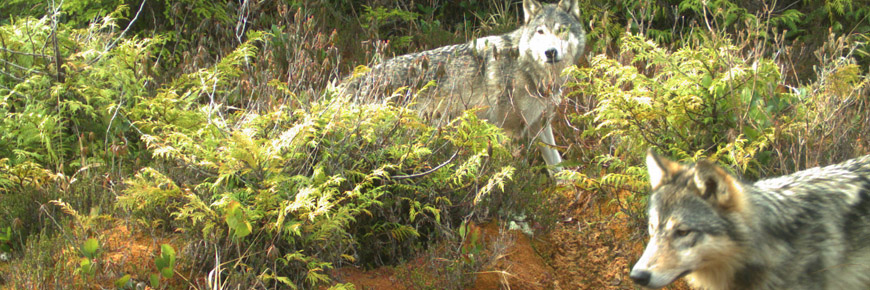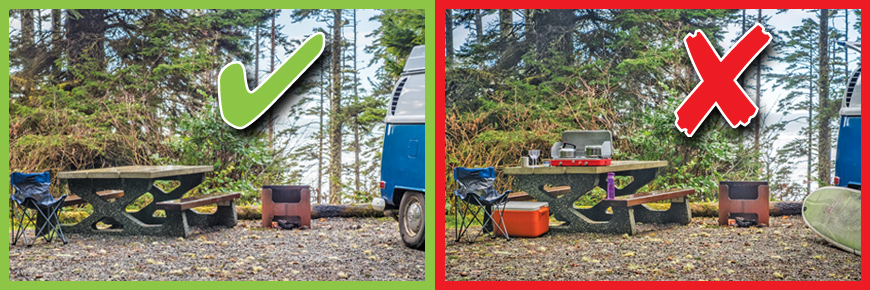
Keep the "wild" in wildlife
Pacific Rim National Park Reserve
Due to the increase in reports of human-wildlife interactions on the West Coast Trail, Parks Canada strongly recommends that a minimum of one person per group carry bear spray and know how to use it. More information.
The activities of wildlife and the public are sometimes in conflict. A conflict can range from a black bear coming into a campsite to investigate the smell of a forgotten tube of toothpaste, to a dog chasing foraging shorebirds, to a wolf attacking an unleashed dog.
In the case of immediate conflict, if you encounter or are approached by wildlife:
- Act Big
- Make Noise
- Don’t Run
If you encounter a black bear…
As a national park visitor, you share this natural area with black bears and other wildlife that depend on it for survival. Although bears are naturally wary of humans, the large population on Vancouver Island means that encounters with humans are common. For information on what to do if you encounter a bear, see our ‘You are in Bear Country’ page.If you encounter a wolf or cougar…
- Pick up small children.
- Gather the group together.
- Do not run.
- Do not crouch down.
- Make and maintain eye contact.
- Wave your arms and shout.
- Never approach a carnivore or its den site.
- If you encounter wolf pups or cougar kittens, leave the area immediately. Do not approach.
If a wolf or cougar doesn’t move away…
- Convince it that your group is not prey and that you are dangerous!
- Do not turn your back. Maintain eye contact.
- Do all you can to appear larger.
- Avoid scaring the animal into the path of other people.
- Use a noise maker like an air horn or throw things if necessary.
If a wolf or cougar approaches you…
- Throw sticks, stones, etc., or use bear spray. Be sure you know how to use it first!
- If the aggression escalates, fight back with a stick, your fists, or whatever is at hand.
- Hit the animal in the eyes and nose.
If you see an animal carcass…
- Leave the area immediately and notify park reserve staff.
To reduce immediate and long-term conflict, Parks Canada promotes human-wildlife coexistence.
What does coexistence mean?
- To exist together or at the same time.
- To live in peace with each other.
Parks Canada uses a variety of measures to promote human-wildlife coexistence.
What do we do to promote coexistence?
1) The BARE Campsite program
Pacific Rim National Park Reserve has a BARE campsite program in place. A special effort is being made by both park reserve staff and campers to ensure that wildlife attractants are never left unattended at any campsite. The BARE campsite program is in place for your safety, and to help keep the wildlife in our national parks alive and wild.
Keeping a BARE campsite
If you are camping in a national park, you are agreeing to store all food and wildlife attractants in a hard-sided vehicle such as a trailer or motor home, or in the campground food storage lockers (not in a tent or tent-trailer) when not in use.
This policy applies whenever these items are not in use, such as while you are sleeping at night, or when your site is unattended for any length of time (e.g., to go to the washroom).

A BARE campsite, and a campsite that puts wildlife and people at risk
Attractants are things that have an odour or could appear to be food to wildlife. Your campsite should look like the picture of the BARE campsite.
Wildlife attractants include:
- coolers – full or empty
- food and condiments
- garbage, wrappings, or plastic bags
- pet food or bowls
- bottles or cans – full or empty
- toiletries, sunscreen, or insect spray
- camp stoves or barbeques
- food preparation or clean up items (pots, dishes, soap, dish cloths, tablecloth, etc.)
- grey water pails
To learn more about habituation and food conditioning and why they put wildlife at risk, see our FAQ page.
2) Education through interpretation
An exciting variety of guided walks and talks are offered by interpreters on a regular basis throughout the summer. Check out our free daily programs for a fun opportunity to learn about wildlife coexistence, animal tracking, scat, skulls, ecology, and more!
3) Wildlife Ambassador program
Pacific Rim National Park Reserve’s Wildlife Ambassador program aims to improve visitors’ understanding and appreciation of the wildlife and natural hazards in this area. The Ambassadors roam beaches and trails in the summer, interacting with visitors on topics ranging from water safety, to appropriate shorebird watching tips, to dogs-on-leash compliance.
4) Warnings and closures
Under the Canada National Parks Act, there are regulations to protect both wildlife and visitors. Parks Canada staff close areas such as trails and campsites periodically to prevent human-wildlife conflicts.
These closures serve two purposes:
- They allow wildlife in national parks undisturbed access to sites important to them, such as feeding areas, den sites, and other seasonally important areas.
- They keep humans out of areas where there is an increased risk of human-wildlife conflict.
Click here for a list of current closures, warnings, and advisories in Pacific Rim National Park Reserve.
What can you do to promote coexistence?
- Report all wolf, cougar, and bear sightings to Parks Canada staff at 250-726-3604.
- Scare, do not stare! Instead of stopping to take a picture, help reinforce natural, healthy wariness of humans – make noise, act big, and do not run!
- Follow the guidelines for pets in Pacific Rim National Park Reserve. Keep dogs on leash.
- Avoid hiking alone and keep children close. Discuss wolf, bear, and cougar safety before your visit.
- Give wildlife space! Create and maintain distance from all wildlife.
- Follow these 10 tips on how to respect wildlife and stay safe.
Related links
- Date modified :